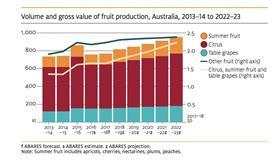
Australian produce may not be able to compete on price in overseas export markets, but it can compete on quality, reliability, and safety, according to ABARES’ senior economist Caroline Gunning-Trant.
“Exports of fresh horticultural produce were worth more than $2bn [including tree nuts] in 2016 to 17, with strong growth in fruit and nut exports over the past five years,” she said.
Meeting the expectations of consumers was a key takeaway point for delegates at the ABARES Outlook 2018 conference today in Canberra.
Gunning-Trant said that a demand from Asia for Australian produce, coupled with favourable exchange rates and improved access, have supported Australia’s recent export growth.
Over the six years to 2016-17, Australia’s fruit and nut exports to its top five destinations more than doubled, and the value of vegetable exports increased 50 per cent. This has continued over the past calendar year as overall Australian fresh fruit exports exceeded A$1.1bn for the first time ever.
Moving forward
The ABARES Outlook 2018 Agricultural commodities report has forecast overall Australian agricultural exports to increase by A$3bn over the next five years, continuing the upward trend. However, due to record production in 2016-17, the gross value of overall farm production is forecast to decline in 2017-18 by five per cent.
Internationally, Australian horticultural goods are a high value sector, and Elliot Jones, general manager – grape and citrus at Costa Group understands the importance of customer expectations to create sustainable markets and solidify Australia’s premium stance.
“China is a fast-growing market where consumers are increasingly brand and quality conscious. … Our brand and quality consistency will be key to sustaining those markets,” he said.
In terms of competing with China’s own supply, the report also mentioned that the Chinese fruit industry is “not expected to produce sufficient quality fruit to displace imports from Australia over the medium term.”
Jones also stresses the importance of maintaining and improving market access protocols as critical to the industry’s success.
Domestically, the ABARES Outlook 2018 report also anticipates “moderate growth” for fruit, with Australian production and demand expected to increase, but per person fruit consumption to not growing significantly.
Throughout the next five years domestic fruit prices are expected to fall due to increased competition.
For vegetables, overall production in 2016-17 saw a two per cent drop in value, which is expected to increase by A$2m to A$3.8bn in 2017-18, far less than the two per cent decrease from 16-17.
Growth in tree nut production has been significant, and is expected to correct itself as the continuously increasing global supply outpaces demand for growth.
High costs of irrigation for Australian growers is also expected to raise overall production costs meaning the industry will need to invest in supply-chain efficiencies and value-adding opportunities.



